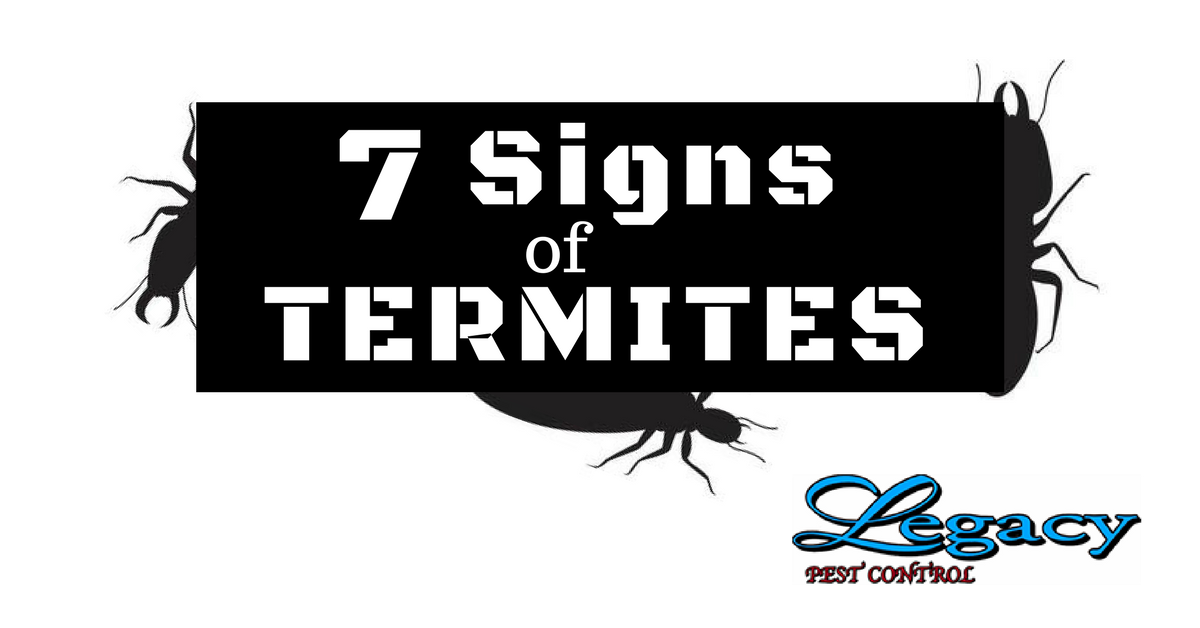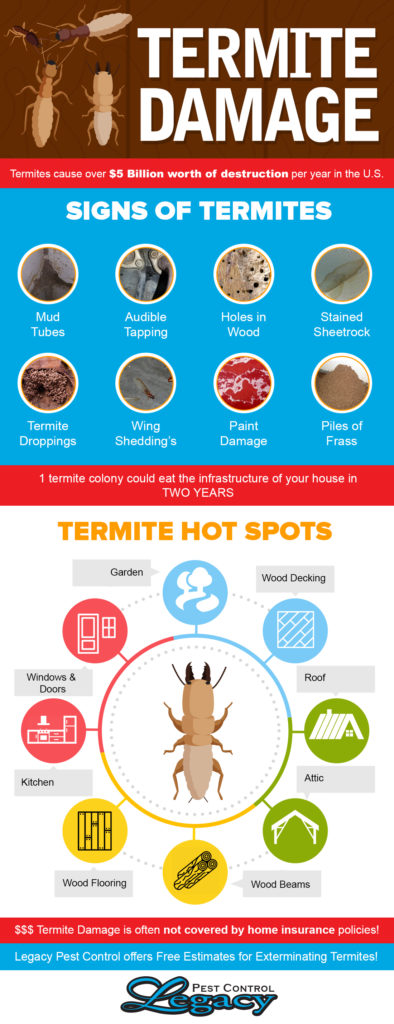7 Signs of Termites

Gone unnoticed, termite armies can cause significant damage, costing homeowners in Utah thousands of dollars in repairs. The subterranean termite is the most common termite species in Utah, known to live on cellulose (the major component of lumber), these little pests are rarely seen and can be the cause of major structural problems. While identifying a termite infestation can be tricky, there are a few tell-tell signs that can help you determine If your home has a termite problem.
Although it is rare to see termites out in the open, it is a good idea to know their identifying features. Many people mistake termites for ants because of their similar shape, size, and even behavior. Homeowners need to know that there is no such thing as white ants, if you see insects that you suspect are termites, it may be time to seek professional help from a reputable pest control service to prevent costly damage to your home. Here are a few distinguishing characteristics of the subterranean termite, commonly found in Utah:
- 1/4″ to 1/2″ in Length (kings & queens can reach over 1″ in length)
- Soft, Thick Bodied
- White or Creamy Colored
- Pale Translucent, Veiny Appearance
- Straight Antennae
Beyond identifying these rarely seen pests, there are several other warning signs to watch out for if you suspect your home is being invaded by termites.
#1 Watch for Flying ‘Ants’
Those flying ‘ants’ may actually be termites. Usually the first sign of termites, these winged insects are also known as reproductives or swarmers (alate) and can be distinguished from flying ants by their two sets of wings, equal in length. Swarmers are both male and female termites that have left an already established colony to find a mate and establish a new colony; these paired termites are the king and queen. Finding the swarmers discarded wings is another sign to watch for.
#2 Termite Droppings
Termite droppings, known as frass, are a direct indication of a drywood termite infestation. Although uncommon in the state of Utah, drywood termite problems can happen. Frass can be found near the termite nest entrance and is identified as a dark powder substance or small black marks from where they push the frass out of the nesting area through small holes.
#3 Audible Clicking in The Walls
Soldier termites make a quiet clicking sound as they bang their heads against wood or shake their bodies to signal danger if the colony is disturbed. If you put your ear up against a wall infested with termites you can even hear the worker termites gnawing away at the wood.
#4 Hard-to-Open Windows and Doors
If you’re experiencing more difficulty in opening and closing your windows and doors, it may be a result of termites. Warped wood can be a result of the moisture produced by termites when they eat. While the weather or outside temperature may be to blame for stiff windows or sticking doors, this problem combined with any of the other listed signs may indicate you have a termite infestation.
#5 Mud Tunnels
Mud tunnels, sometimes called mud tubes are made primarily out of dirt and also include other organic material, like termite feces. Mud tunnels are created by the termites to easily access their food sources and to maintain the warm, humid environment for food storage. Look for mud tunnels in the following areas:
- Foundation Slab – Subterranean termites will build tunnels to access the wood in your home by going over the concrete foundation slab.
- Attic – Termites are attracted to the exposed wood commonly found in the attic of many Utah homes. Mud tunnels can be seen branching out between the beams like a termite superhighway, giving easy access from beam to beam.
- Garage – Mud tunnels created over concrete give the termites the perfect trail to branch out from the colony to different food sources.
- Basement or Crawlspace – Many mud tunnels are found out of sight in the basement or crawlspace under your home. These mud tunnels are built to lead the worker termites to wood sources, drywall and even furniture.
#6 Papery Wood
Wood that feels papery or hollow sounding can be a good indication of tiny, unwanted houseguests. Termites consume wood from the inside out, leaving only a very thin layer of wood behind. In some cases, termites will eat away at everything, only stopping at the paint or wallpaper.
To investigate your walls, carefully tap or knock on the suspected area; if the wall sounds hollow or papery, you may have severe termite damage.
#7 Wood ‘Galleries’
Discovering wood galleries or tunnels is a sure sign of termite activity. Tiny holes in walls, exposed wood, furniture and attic beams rarely happen naturally, it is most likely damage from termites. When you notice these little burrowing tunnels, it is time to call a trusted expert pest control company to help you determine the extent of the damage and get the infestation under control.
Trust Legacy Pest Control for Termite Control in Utah
Legacy Pest Control is a family-owned business proudly serving Northern Utah residents and property owners for over 20 years. Our termite treatment plans are tailored to each individual situation and are safe, effective and affordable. We confidently back your pest control service with a satisfaction guarantee. Our friendly, professional pest control technicians pledge to arrive on time, respect your home and use pest control products that are safe for kids and pets. Click Here for your fast, free termite control quote or give us a call at 801-779-3131.
Latest posts by Legacy Pest Control (see all)
- When Should You Call a Professional for Pest Problems? - March 10, 2025
- Are Businesses Required to Have Pest Control? - February 12, 2025
- Do I Need Pest Control in Winter? - January 15, 2025




